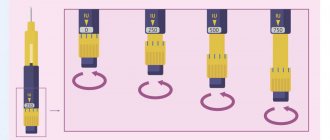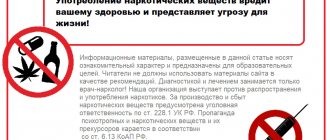Naloxone
The rate of administration of Naloxone should be selected individually, depending on the patient's response to the use of naloxone and previously administered single doses.
Naloxone is used intravenously, intramuscularly or subcutaneously.
In the case of infusion use, the Naloxone solution is diluted in a 0.9% sodium chloride solution or in a 5% dextrose solution as follows: 2 mg (5 ml of a solution containing 400 mcg/ml naloxone) is added to 500 ml of infusion medium.
The resulting solution after dilution contains 4 mcg of naloxone per 1 ml. The solution is prepared immediately before use.
The dose of Naloxone and method of administration depend on the patient's condition and the type and amount of opioid taken.
Acute poisoning (overdose) with opioid analgesics
Adults
The initial single dose is 400-2000 mcg, which is administered intravenously slowly (over 2-3 minutes). If necessary, the dose can be re-administered after 2-3 minutes, until consciousness is restored and breathing is uniform. If, after administration of a total dose of 10 mg, there is no restoration of consciousness and breathing, another (non-opioid) cause of poisoning should be assumed.
Naloxone can also be used intramuscularly or subcutaneously. In life-threatening conditions, the preferred route of administration is intravenous.
Children
The initial single dose is 10 mcg/kg, which is administered intravenously slowly (over 2-3 minutes). If necessary, an additional dose of 100 mcg/kg can be administered after 2-3 minutes.
If it is impossible to use naloxone intravenously, it is administered intramuscularly or subcutaneously in fractional doses at intervals of 2-3 minutes. With intramuscular administration, the effect of the drug appears more slowly. A single dose of about 200 mcg (i.e., about 60 mcg/kg) can be administered, resulting in a longer-lasting effect.
Postoperative use: to speed up recovery from general anesthesia (if narcotic analgesics were used during the operation)
Adults
The drug is administered intravenously at a dose of 100-200 mcg (1.5-3 mcg/kg) every 2-3 minutes until adequate pulmonary ventilation appears and the patient awakens, but without distinct pain and discomfort. A dose exceeding the minimum required may cause cessation of analgesia and an increase in blood pressure, as well as other symptoms: nausea, vomiting, increased sweating, dyscirculatory crisis. In some cases, especially after taking opioid analgesics with a long duration of action, it is necessary to administer an additional dose of naloxone intramuscularly over 1-2 hours. The drug is also administered by intravenous infusion.
Children
The drug is administered intravenously at a dose of 10 mcg/kg. If necessary, an additional dose of 100 mcg/kg can be administered.
If it is impossible to use naloxone intravenously, it is administered intramuscularly or subcutaneously in fractional doses at intervals of 2-3 minutes. With intramuscular administration, the effect of the drug appears more slowly. A single dose of about 200 mcg (i.e., about 60 mcg/kg) can be administered, resulting in a longer-lasting effect. The drug is also administered via intravenous infusion.
Restoration of breathing in newborns after administration of opioid analgesics to the mother in labor
Newborns
Before administering the drug, it is necessary to ensure that the newborn's airway is open.
The drug is administered intravenously, intramuscularly or subcutaneously at a dose of 10 mcg/kg. If necessary, the dose can be repeated after 2-3 minutes.
After the birth of a child, 200 mcg (i.e., about 60 mcg/kg) of naloxone can be administered intramuscularly for preventive purposes.
As a diagnostic tool in patients with suspected drug (opioid) addiction
An IV dose of 0.5 mcg/kg can help determine whether respiratory depression or difficulty urinating is caused by opioids. The dose of naloxone can then be increased, avoiding too high doses. Large doses remove any effect of the opioid, incl. and analgesic, and also lead to stimulation of the sympathetic and circulatory systems.
Naloxone
Naloxone
(eng.
naloxone
) is a drug used for poisoning with opioid analgesics. Peripheral opioid receptor antagonist. In recent years, it has also been marketed as a laxative for the treatment of constipation in patients taking opiates.
Naloxone is a chemical compound
The chemical name of naloxone is (5alpha)-4,5-Epoxy-3,14-dihydroxy-17-(2-propenyl)morphinan-6-one. Empirical formula: C19H21NO4. Molecular weight 327 g/mol.
Naloxone is the international nonproprietary name of the drug
In the ATC, naloxone is included in the following sections and groups:
- "V03AB Antidotes", code V03AB15
- “A06 Laxatives”, subgroup “A06AH Peripheral opioid receptor antagonists”, code A06AH04 (included in the ATC in 2017)
In addition, as of 2021, the name of the existing code has been changed to explicitly mention naloxone:
- "N02AA55 Oxycodone in combination with naloxone" (group "N02 Analgesics")
According to the Pharmacological Index, naloxone is classified in the groups “Detoxifying agents, including antidotes” and “Opioid non-narcotic analgesics”.
Naloxone is an antidote
Indications for the use of naloxone:
- overdose, acute poisoning with narcotic analgesics (morphine, trimeperidine, fentanyl, buprenorphine, pentazocine, butorphanol, nalbuphine and others) or overdose of other drugs (for example, loperamide)
- post-operative use: acceleration of recovery from general anesthesia, before the end of controlled breathing
- applies only if narcotic analgesics were used during anesthesia
- not effective for the treatment of respiratory depression caused by substances other than opioids
Procedure for using naloxone in case of acute poisoning or overdose
Naloxone is administered intravenously for life-threatening conditions. In other cases, it can be administered intramuscularly or subcutaneously, but in this case the effect occurs later. Each dose of the drug is injected into a vein slowly, over two to three minutes. then before the next dose (if necessary), take a break for two to three minutes. Adults:
The initial dose is 400-2000 mcg. If necessary, the dose is repeated one or several times, until consciousness is restored and breathing is uniform. If, after administration of a total dose of 10 mg, there is no restoration of consciousness and breathing, the cause of poisoning is most likely not related to opioid drugs.
Children:
the initial dose is calculated based on 10 mcg per 1 kg of patient weight, which is administered intravenously. If necessary, an additional dose is administered after two to three minutes based on 10 mcg per 1 kg of weight. If intravenous administration of naloxone is not possible, it is administered intramuscularly or subcutaneously in fractional doses at intervals of two to three minutes. A dose of about 200 mcg (approximately 60 mcg per 1 kg of weight) can be administered once, obtaining a longer-lasting effect.
Naloxone is a laxative.
Naloxone will accelerate intestinal transit and is used for some forms of functional constipation (Pasechnikov V.D.).
Naloxone is also used to treat constipation in patients taking opiate pain medications. On the website in the literature catalog there is a section “Laxatives”, containing medical professional publications relating to the use of laxatives.
Use of naloxene during pregnancy and lactation
Naloxone is FDA Category C for fetal risk use in pregnant women (animal studies have shown adverse effects on the fetus and there have been no adequate studies in pregnant women, but the potential benefits associated with use of this drug in pregnant women may justify it use despite the risk).
It is unknown whether naloxone is excreted in human milk, so either its use by nursing mothers is not recommended or it is suggested that breastfeeding be interrupted for 24 hours after naloxone administration.
general information
Naloxone is a prescription drug.
All monocomponent drugs using naloxone as an active ingredient and approved for use in Russia have the trade name Naloxone and are available in the form of injection solutions. Naloxone is approved for use in the United States and is sold there under the trade names: Evzio, Narcan Injection, Narcan Nasal Spray and others. Narcan Nasal Spray, a nasal spray containing naloxone hydrochloride, was approved by the FDA in 2015.
The drug Targin with the complex active ingredient “oxycodone + naloxone” (dosage form - long-acting film-coated tablets) is also registered in Russia. A similar drug, Targin, is sold in many Western European and southeastern countries. Targiniq ER, a drug with the same active ingredients, is approved for use in the United States.
Information for US healthcare professionals (in English, pdf): “Narcan (naloxone hydrochloride) nasal spray. Full Prescribing Information".
Naloxone has contraindications, application features and side effects. Before use, consultation with a specialist is necessary.
Back to section
Naloxone
The rate of administration of the drug should be selected individually, depending on the patient's response to the use of naloxone and previously administered single doses.
Naloxone is administered intravenously, intramuscularly, or subcutaneously.
In the case of infusion use, the naloxone solution is diluted in a 0.9% sodium chloride solution or in a 5% dextrose solution as follows: 2000 mcg (5_ ml of solution containing 400 mcg/ml naloxone) is added to 500 ml of infusion medium. The resulting solution after dilution contains 4 mcg of naloxone per 1 ml. The solution is prepared immediately before use.
Dosage regimen
The dose of naloxone and method of administration depend on the patient's condition and the type and amount of opioid taken.
In case of acute poisoning ('overdose') with narcotic analgesics.
Adults
The initial single dose is 400-2000 mcg intravenously slowly (over 2-3 minutes). If necessary, the dose can be repeated after 2-3 minutes, until consciousness is restored and breathing is uniform. If, after administration of a total dose of 10 mg of naloxone, there is no restoration of consciousness and breathing, another (non-opioid) cause of poisoning should be assumed.
Naloxone can also be administered intramuscularly or subcutaneously. In life-threatening conditions, the intravenous route of administration is preferable.
Children
The initial single dose is 10 mcg/kg intravenously slowly (over 2-3 minutes). If necessary, an additional dose of 100 mcg/kg can be administered after 2-3 minutes.
If it is impossible to use naloxone intravenously, administer it intramuscularly or subcutaneously in fractional doses at intervals of 2-3 minutes. When administered intramuscularly, the effect of the drug appears more slowly. A single dose of about 200 mcg (i.e., about 60 mcg/kg) can be administered, resulting in a longer-lasting effect.
Postoperative use: to speed up recovery from general anesthesia / if narcotic analgesics were used during the operation.
Adults
Intravenously, 100-200 mcg (1.5-3 mcg/kg) of naloxone solution every 2-3 minutes until adequate pulmonary ventilation appears and the patient awakens, but without distinct pain and discomfort. A dose exceeding the minimum required may cause cessation of analgesia and an increase in blood pressure, as well as other symptoms: nausea, vomiting, increased sweating, dyscirculatory crisis.
In some cases, especially after taking opioid analgesics with a long duration of action, it is necessary to administer an additional dose of naloxone intramuscularly over 1-2 hours.
The drug is also administered via intravenous infusion.

